Work is progressing on a huge new shipbuilding facility in Glasgow.
When complete, two Type 26 frigates will be built side-by-side in the new facility – considerably speeding up construction.
The existing sheds at Govan only allow for fore and rear sections of the frigates to be built under cover – the giant segments are then joined together on the standing at Govan (which is where HMS Cardiff currently sits). That means for months on end the ships are exposed to the elements – slowing/restricting work on the vessels which will replace the eight dedicated submarine-hunting Type 23s in service.
Work on the foundations – filling in a basin – has been completed and piling started on the new hall which is more than one and half times the length of Hampden Park pitch at 170 metres long and ten wider at 80 metres across.
Once complete, the New Ship Build Hall will be equipped with two 100-tonne cranes and a further two 20-tonne cranes, with up to 500 workers employed per shift on frigate construction. As well as being spared batterings from the Scottish weather, ships will emerge from the new hall in a more complete state.
The new complex is part of a £300m investment in BAE’s facilities on both sides of the Clyde, not least increased digitisation of work processes.
“This new hall will give us some of the best facilities in the world and completely modernise our approach to shipbuilding,” said Simon Lister, Managing Director of Naval Ships at BAE Systems.
“It, alongside the investments already under way to digitise our processes, will ensure Govan continues to be something that the city of Glasgow can be truly proud of.”


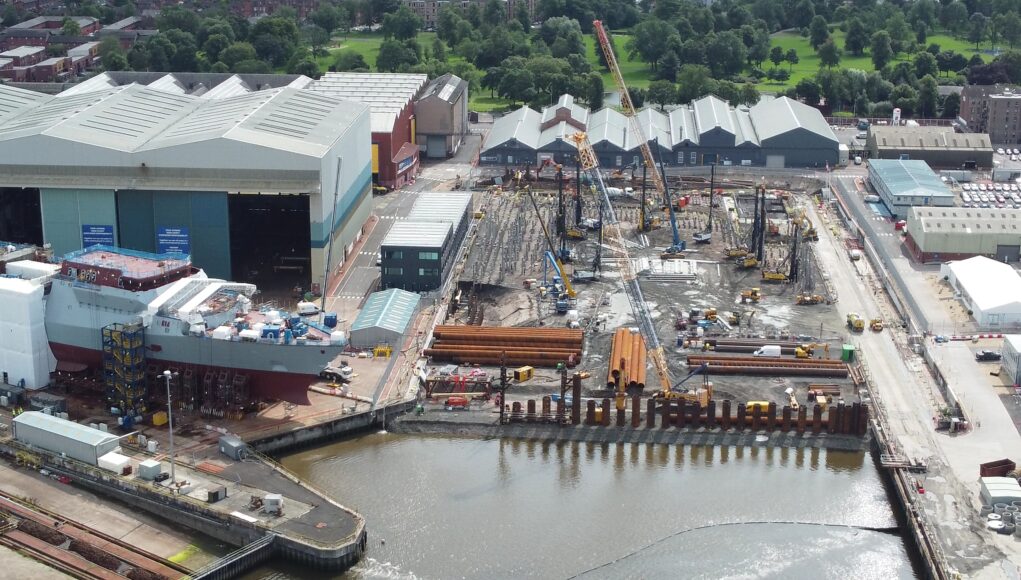

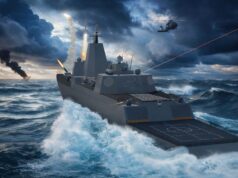
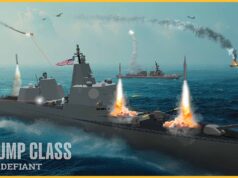



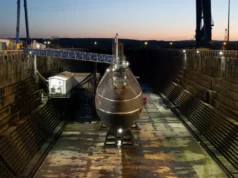

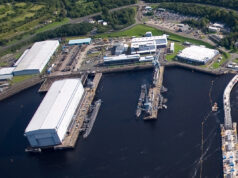


Need someone wot has knowledge of builders stuff to comment please.
I saw that they had driven loads of piles in and then poured concrete over them for the base, but they now seem to be drilling through the concrete to put more piles in?
Ditto the cofferdam wall, which is now receiving tubular piling?
I only hope further orders are forthcoming in order to make this investment worthwhile…
AA
It is called a piling mat.
It is usually a 6” concrete slab with a layer of A393 mesh in it – same as a garage forecourt.
The mat means that the piling rig can be aligned precisely so the bored piles can be inserted more precisely.
If the piling rig is not precisely aligned the piles go all over the place.
I am not familiar with progression photos, but I have done a fair amount of piling. The tubular piling you refer to may be the start of a secant pile wall as the cofferdam sheet piles are likely temporary and may not have the design life for the water (saltwater?).
For your other point, I am not sure unless I see photos, but another comment suggested it is a piling mat, but this makes little sense to me as piling to allow construction of a piling mat to do more piling does not make logical sense when I have a 140t piling rig sat outside my office on 1m thick of 6n technical fill, which could have been the fill for the basin?
The mat design will depend on geotechnical conditions, but I assume this basin was concrete lined so ground conditions should be sufficient, especially as it was likely consolidated by self weight of water and or ships in the basin. Difficult to say.
I could speculate that the initial set of piles reduced the loading on the concrete basin as it was likely in a poor state and the concrete you have seen cast could be used as a guide wall for the piling rig to ensure a great er tolerance for accuracy.
For example one of my piling rigs will put piles in to a positional tolerance of 75mm in plan and vertical tolerance of 1in 75 (difference in vericality between top and bottom) of a 750mm wide CFA. If the piles are located close to each other and the piles are long enough, the toe of the piles could clash. A guide wall will reduce this postioanl tolerance to 25mm and also improve the verticality, difficult to say how much though.
I’m not an expert and I’ve not seen photos.
I agree with most of that.
My piling experience is with much smaller rigs than the one you are discussing.
There is something slightly unusual about the piling strategy here.
It will be for very good engineering reasons.
For instance why was the ground, to left of shot, filled level and the scraped back?
I think it us to do with precision for the very high load piles that need to go down well below the floor of the existing basin.
Sometimes, on site, we put down a concrete cap layer just to keep the place tidy so it isn’t churned up by all the plant in the wet.
We can then do the structural concrete work above that very precisely in a relatively clean environment.
So, once this is completed and combined with the existing facilities would we have the capability to build 3 Type 26’s at the same time? It would seem like an awful shame for the government not to take advantage of that with more orders!
Well, yes, but 1 of those would be at far slower pace, in pieces. Would create different work rates, not to mention Industrial Relations issues as the workers on the frigate being built outside moan about their colleagues in the warm hall 100 metres away.
I’d probably look to use the existing small hall for manufacture of replacements for the B2 Rivers, and maybe sections of even larger ships that wouldn’t fit whole in the new hall either?
Building indoors will be plain more efficient. Humans work best out if wind and rain. Soggy humans are inherently inefficient.
The existing halls will be used to fabricate blocks.
So inherently there will be better throughout.
Will be interesting to see what comes next after the T26s in those halls. Would be great to get some decent replacements for the B2 Rivers. I’m not a hater on them, but we could certainly do with more than we have, with some updated armament now that we have more options (57 mm, anyone?). I am maybe alone in thinking they probably don’t need missile armament- they’re for constabulary duties, like they’re doing now.
But they don’t need block-fabrication. Are you thinking T83, or support vessels?
Yes the present Halls gives options for smaller vessels to be built as well as T-26 or ship sections as you describe generally but could not T-26 sections be built up in the smaller halls and then transferred to the large halls to be joined so that theoretically at least a faster flow of construction could occur.
Good point, honestly I don’t know. movements of large sections have to be very carefully planned and executed, so there’s some added complexity there, even if they’re moving a few hundred metres. That said, it may shorten the overall programme.
My understanding though was that the programme was at the speed it was to control in-year cost, rather than capacity. I may be wrong though…
This was the case with batch 1. The new batch 2 contract is expected to be built faster. Whether that’ll be at the fastest rate BAE can build them, I don’t know.
But it impacts the global cost of follow on projects if they are more efficient?
Existing small halls are still used for intial block build- just they are moved next door to the final assembly hall which would be dedicated to putting these blocks together from bow to stern
that might be more of a workforce question – are there enough skilled engineers etc to do that much work at once?
fab shed will struggle to supply the 3 bays and the new halls (time wise) some units are in the fab shed over 6 months be interesting to see how they plan to keep supply up to speed once up and running
think if thinks kick off it will be running 24/7
Hopefully the build hall dimensions are generous enough and have taken into account the future destroyers potential dimensions…
They have. The type 83 would have to be a gigantic vessel more like a large heavy cruiser to not fit in.
So the shed is built for, not necessarily with type 83s. Well somebody had to say it.
😀
Having worked in a covered hall in yards in Scotland and Norway, the sheltered space allows better access to work areas and means less slippery walkways and stairs. It al helps the efficiency and safety. Having space for 2 vessels means efficiency for installation, install one widget in 8hrs on number 1. Then widget on 2nd vessel takes half the time.
Also means despite the lovely weather – like we are experiencing right now- everything is not getting wet and cold. Means Less corrosion occurring too.
Really good to see common sense & investment to improve working environment.
Can’t wait to see these T26 in the water and keeping the Putinist Russians on their toes.
BAE are greedy buggers. They should’ve built the new sheds the minute the type 26 contract was awarded for batch 1. It was only when there was a whiff of type 83 follow on construction that they pulled their fingers out and did what they should have done from the start.
I suspect they would have saved more than £300m by build the hall from the off!
It also eases recruitment as it makes it a less old school working environment.
Yes it rather reminds us of the lack of lateral thinking and wider implications being taken into consideration in decisions in this Country generally. It’s ironic that it’s often talked of that a return to ‘ Victorian Values’ would be beneficial but in truth in engineering and creativity and indeed financing projects the Victorians were anything but conservative as we think of them today. Indeed it was the loss of such chance taking that has increasingly created the malaise we have now when it comes to innovation and the like or forward thinking. The creativity remains in droves but as Alan Bond said a few years back while the powers that be managerial, financial and political here may enthuse initially about projects and ideas, they almost inevitably lose interest when it comes to pushing onwards to make it a reality or even further development once it is. Sounds about right to me.
Probable because the Nat’s are still going on about independence and the batch 1 may have been the last ships built at Goven & Scotstoun, so why invest when the second batch may have not been built there.
The orginal proposal pre indref’14 was to be at Scotstoun yard as BAe own this yard and rent Goven from GCC.
The proposal for a frigate factory at Scotstoun and to close Govan wasn’t cancelled because of the indref. It was canned in 2015 after the SDSR when the T26 order fell from 13 to 8. The worst part is, BAE had got so far as to demolish lots of Scotstouns substantial facilities in order to prepare for the factory, which was then canned.
Remnants of Ben Wallace, of late renown. Recall reported on this site previously that he told them to get their investment act together rather than attempting to pull a fast one – jury’s still out as to whether Shapps will be Granted similar accolade.
Looks like they’ve gone from closing Govan in favour of Scotstoun, to Clyde retaining two Bae sites with further development potential. Feel we’ll need every maritime surface and subsurface construction facility we can get our hands. RN is still our most valuable military contribution, combined with aerospace assets.
Trust known aggressors will be patient enough to let us finally detox from the Peace Dividend.
Separately, I’m certainly not anti-US, they’re a fantastic ally second to none. However, on you’re subject of ‘cake size’, they do need to reassess the amount they wish to both have & eat. 1st SL Ben Key diplomatically touched on subject, evidently acknowledged, whilst attending CSIS the other day.
Also bear in mind that the land previously cleared at Bae Scotstoun is apparently now earmarked for a “shipbuilding academy” although afaik nothing has yet moved on re. the start of that.
Thanks; interesting to monitor where that goes.
The build at Scotstoun for the new Skills Academy has commenced and is scheduled to be completed by Summer 2024 – in time for the next new intake of 200 apprentices/graduates.
Has it? They don’t seem to have been granted planning permission yet. https://publicaccess.glasgow.gov.uk/online-applications/applicationDetails.do?keyVal=RT92C4EXJXI00&activeTab=summary
They were required to submit a full new planning application mid-September https://publicaccess.glasgow.gov.uk/online-applications/files/D6B7AB12CB9DEA5EB5F0E73B0433596D/pdf/23_00920_FUL-ADDITIONAL_FULL_PLANNING_APPLICATION-5866291.pdf
Also, I live locally & would have expected to see increased traffic activity if the build had started & I have not.
So, I had reason to be in Braehead early this afternoon which gave me a good opportunity to inspect the Bae academy site from across the river – nothing appeared to have materially changed from how it has been for months if not years & there was no obvious work going on.
I also got to go & have a good keek at the Nato warships in King George V dock pre-Joint Warrior. 🙂
I was told by a BAE contact last week that they have already started at Scotstoun (planning permission did crop-up during the conversation!). Perhaps it’s just preparatory works.
I’m surprised as training the workforce is the longest lead time item.
Maybe it is the BAE game of chicken – give us T83 etc and we build the academy – a well worn negotiating tactic….mind you that lost them 5 x T26 hulls.
To be fair to BAE Systems, I can understand the historical reluctance to build a large build hall, when they saw the T45 order cut in half to 6, then the T26 order cut from 13 to 8.
Other players awarded the T31 contract and more reason for hesitation.
The upcoming T83 design will be at least 9,000 tons and should be an order of at least 6, the size and complexity of the ship mean BAE Systems have it in the bag, (9 would be sensible), so it’s worth it’s construction now.
As the world continues to destabilise, the defence budget has to go to 2.5 GDP, hopefully with it an increase in the size of the RN and more use for this new build hall
There was never a T45 *order* for 12 ships. It was just a projection from the existing T42 numbers.
Actual orders for T45 were 8 , with the last 2 as options- the RN traded away the last 2 for moving the T23 replacement type to follow on fairly closely. (That would have have almost continuous build on the Clyde)
‘The 2010 election cuts put that on hold – or officially as ‘search for a cheaper design’- until just before the 2015 election when the same earlier project became the T26 order. 5 years with money wasted on Rivers and now expensive T23 refits
Please don’t reply to my posts Dunker.
I dont answer to you my friend.
The answer is for the other readers, unlike your self I literally dont care if you dont like it .
Yet he answers again anyway …. 😵💫😵💫😵💫
I thought the RN traded hulls 7 and 8 of the Type 45’s to maintain the buy/contract for the QE and POW?
As Duker said Hulls 7 & 8 were deferred to expedite work on the GCS which became Type 26,nothing published to link them to the Carriers.
There was a ca £6Bn budget for project T45.
With R&D costs as well as build of #1-6 there wasn’t enough in the kitty for #7&8.
Conversation with G Brown was along the lines of you can have 7&8 if you push GCS back or cancel 7&8 to pull GCS forwards. You choose.
Alan West chose to pull GCS forward. Which M, now we look at T23 refit costs was very logical.
Would have save T23 LIFEX and RIVER build costs.
Nothing to do with QEC.
Thanks for the answers, my memory is playing tricks on me!
The Canadian government recently shelled out $400 million in a similar initiative to speed up the role out of the T26 in Halifax.
Recently, I was told that BAE now view Govan and Scotstoun (4 miles apart) as essentially a single integrated shipbuilding facility on the River Clyde.
Apart from the new Build Hall at Govan, sometimes missed in commentary is the new hi-tech Panel Line also being constructed within the yard.
BAE productivity has been impacted by skills shortages. The company has big hopes for the new Skills Academy at Scotstoun (opening Summer 2024): a purpose-built facility to develop its own high-skilled workforce. Currently, 200 new apprentices/ graduates are being employed each year.
Company executives are bullish that they are creating a world class shipbuilding complex, taking as their inspiration the modern Adelaide yard acquired in 2018.
It’s welcome news; neither Govan nor Scotstoun has seen much investment since BAE took over the sites 20 years ago. The company can now do this because the Government has given it the long-term security of a large order.
Perhaps we’re seeing the output of Parker’s National Shipbuilding Strategy. If so: it’s great news for Glasgow, the Royal Navy and the United Kingdom.
It is good to see that the building is getting there,one of the comments that i read was about upgrade to the yards ,all British shipyards should be upgraded, Belfast, Liverpool, Newcastle, Liverpool, Southampton, Plymouth, Portsmouth, these are places that were the heart of all British shipbuilding, its sad that vosper Thorneycroft,Appledore are gone but I’m not sure ,if anyone can help on this Iwould appreciate it ,the comments have been good
Appledore isn’t gone.
VT was a sad loss because they were thriving purely on exports until the BAE merger.
Southampton no longer has any shipbuilding since VT moved to Portsmouth and the plan for an American yacht company to build a shipyard there fell through.
Plymouth also has no shipbuilding.
The VT/BAE yard at Portsmouth is still standing strong I believe but the loss of expertise is bad.
Swan Hunter was another sad loss and unlike CL or H&W is unrevivable. The only hope for Newcastle is A&P Tyne which does have some space to upgrade.
CL would be quite hard to upgrade due to space and it’s still struggling for orders.
Louis, thank you for your help,our shipbuilding is woeful thanks to the tories and Labour governments of the past who didn’t bother now it’s coming back on them
There isn’t the volume demand to upgrade all the sites. Also upgrades shouldn’t all be simultaneous but staggered so as tech evolves you take advantage of it. Otherwise all your facilities are out of date at the same time.
Better off focusing on making a couple, with the space, state-of-the-art.
Belfast has got plenty of space on-site as has Rosyth.
Govan has a lot of space the other side of the old wet basin. I’m surprised the fab line and block shop were not built that side in new buildings to an optimised throughput?
Anyway what is happening now is great for engineering.
The average build-to-commission time for T26 currently looks like 8 – 9 years.
T45 6-7 years.
Types 22, 23, 42 3- 5 years. It would be good to get back to that pace if we can.
It’s not surprising considering what BAE did in the run up to T26 build.
Ignoring the fact that BAE destroyed VTs very profitable corvette/OPV business, they also messed up for the T26s. For the T45s and carriers BAE had 3 yards;
Portsmouth with a frigate factory similar to the planned one at Govan.
Scotstoun with a covered build dock for 2 ships.
Govan with the old fashioned way with multiple slips and half a dozen cranes.
Starting in 2007 and ending in 2014 Govans cranes were dismantled. BAE Portsmouth was then shut with one of the excuses being it was a bad way of launching ships (what will happen at Govan). Scotstoun was going to be upgraded to have a T26 frigate factory. They got so far as to destroy a lot of the facilities including the covered build dock.
By the time HMS Glasgow had started build there was barely anything left.
Excellent pics George 👍⭐
If we’re switching to ‘Hampden Parks’ as a formal unit of measure, can you provide a conversion factor from double-decker buses?
All good stuff, but we never hulls in the water More than building sites
Orders for 5 more type 31’s